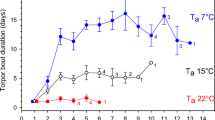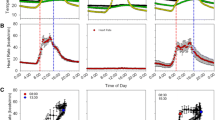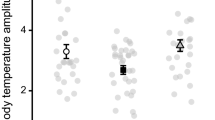Abstract
Tenrecs (Order Afrosoricida) exhibit some of the lowest body temperatures (T b) of any eutherian mammal. They also have a high level of variability in both active and resting T bs and, at least in cool temperatures in captivity, frequently employ both short- and long-term torpor. The use of heterothermy by captive animals is, however, generally reduced during gestation and lactation. We present data long-term T b recordings collected from free-ranging S. setosus over the course of two reproductive seasons. In general, reproductive females had slightly higher (~32 °C) and less variable T b, whereas non-reproductive females and males showed both a higher propensity for torpor as well as lower (~30.5 °C) and more variable rest-phase T bs. Torpor expression defined using traditional means (using a threshold or cut-off T b) was much lower than predicted based on the high degree of heterothermy in captive tenrecs. However, torpor defined in this manner is likely to be underestimated in habitats where ambient temperature is close to T b. Our results caution against inferring metabolic states from T b alone and lend support to the recent call to define torpor in free-ranging animals based on mechanistic and not descriptive variables. In addition, lower variability in T b observed during gestation and lactation confirms that homeothermy is essential for reproduction in this species and probably for basoendothermic mammals in general. The relatively low costs of maintaining homeothermy in a sub-tropical environment might help shed light on how homeothermy could have evolved incrementally from an ancestral heterothermic condition.



Similar content being viewed by others
Abbreviations
- Ta :
-
Ambient temperature measured via a black body apparatus
- T b :
-
Core body temperature
- T soil :
-
Ambient temperature measured at a depth of 250 mm below the surface
- T tree :
-
Ambient temperature measured in a tree cavity
- ∆T :
-
Temperature differential (T b − T a)
- T bmax :
-
Average of the 5 highest T b data for each day
- T bmin :
-
Average of the 5 lowest T b data for each day
- ∆T b :
-
Difference between the daily maximum and minimum T b
References
Anderson KJ, Jetz W (2005) The broad-scale ecology of energy expenditure of endotherms. Ecol Lett 8(3):310–318
Aschoff J (1981) Thermal conductance in mammals and birds: its dependence on body size and circadian phase. Comp Biochem Physiol A 69:611–619
Barnes BM, Kretzmann M, Licht P, Zucker I (1986) The influence of hibernation on testis growth and spermatogenesis in the Golden-mantled ground-squirrel Spermophilus lateralis. Biol Reprod 35(5):1289–1297
Beard LA, Grigg GC (2000) Reproduction in the short-beaked echidna, Tachyglossus aculeatus: field observations at an elevated site in South-east Queensland. Proc Linn Soc N S W 122:89–99
Bieber C, Lebl K, Stalder G, Geiser F, Ruf T (2014) Body mass dependent use of hibernation: why not prolong the active season, if they can? Funct Ecol 28(1):167–177
Boyles JG, Smit B, McKechnie AE (2011) Does use of the torpor cut-off method to analyze variation in body temperature cause more problems than it solves? J Therm Biol 36:373–375
Boyles JG, Thompson AB, McKechnie AE, Malan E, Humphries MM, Careau V (2013) A global heterothermic continuum in mammals. Glob Ecol Biogeogr 22(9):1029–1039
Brice PH (2009) Thermoregulation in monotremes: riddles in a mosaic. Aust J Zool 57:255–263
Brice PH, Grigg GC, Beard LA, Donovan JA (2002) Patterns of activity and inactivity in echidnas (Tachyglossus aculeatus) free-ranging in a hot dry climate: correlates with ambient temperature, time of day and season. Aust J Zool 50(5):461–475
Buck CL, Barnes BM (1999) Temperatures of hibernacula and changes in body composition of arctic ground squirrels over winter. J Mammal 80(4):1264–1276
Burnham K, Anderson D (2002) Model selection and multimodal inference: a practical information-theoretic approach, 2nd edn. Springer, New York
Canale CI, Levesque DL, Lovegrove BG (2012a) Tropical heterothermy: does the exception prove the rule or force a re-definition? In: Ruf T, Bieber C, Arnold W, Millesi E (eds) Living in a seasonal world: thermoregulatory and metabolic adaptations. Springer, New York, pp 29–40
Canale CI, Perret M, Henry PY (2012b) Torpor use during gestation and lactation in a primate. Naturwissenschaften 99:159–163
Careau V, Réale D, Garant D, Speakman JR, Humphries MM (2011) Stress-induced rise in body temperature is repeatable in free-ranging Eastern chipmunks (Tamias striatus). J Comp Physiol B 182(3):403–414
Clarke A, Pörtner H-O (2010) Temperature, metabolic power and the evolution of endothermy. Biol Rev 85:703–727
Clutton-Brock TH, Albon SD, Guinness FE (1989) Fitness costs of gestation and lactation in wild mammals. Nature 337(6204):260–262
Crompton AW, Taylor CR, Jagger JA (1978) Evolution of homeothermy in mammals. Nature 272:333–336
Dausmann KH, Glos J, Ganzhorn JU, Heldmaier G (2005) Hibernation in the tropics: lessons from a primate. J Comp Physiol B 175(3):147–155
Dausmann KH, Glos J, Heldmaier G (2009) Energetics of tropical hibernation. J Comp Physiol B 179:345–357
Douady CJ, Catzeflis F, Kao DJ, Springer MS, Stanhope MJ (2002) Molecular evidence for the monophyly of Tenrecidae (Mammalia) and the timing of the colonization of Madagascar by Malagasy tenrecs. Mol Phylogenet Evol 22(3):357–363
Eisenberg JF, Gould E (1969) The tenrecs: a study in mammalian behavior and evolution. Smithson Contrib Zool 27:1–156
Eisentraut M (1960) Heat regulation in primitive mammals and in tropical species. Bull Mus Comp Zool 124:31–43
Farmer CG (2000) Parental care: the key to understanding endothermy and other convergent features in birds and mammals. Am Nat 155(3):326–334
Farmer CG (2003) Reproduction: the adaptive significance of endothermy. Am Nat 162(6):826–840
Fietz J, Klose SM, Kalko EKV (2010) Behavioural and physiological consequences of male reproductive trade-offs in edible dormice (Glis glis). Naturwissenschaften 97(10):883–890
Fowler P, Racey P (1987) Relationship between body and testis temperatures in the European hedgehog, Erinaceus europaeus, during hibernation and sexual reactivation. J Reprod Fertil 81(2):567–573
Geiser F (1994) Hibernation and daily torpor in marsupials—a review. Aust J Zool 42(1):1–16
Geiser F, Ruf T (1995) Hibernation versus daily torpor in mammals and birds: physiological variables and classification of torpor patterns. Physiol Zool 68:935–966
Geiser F, Holloway JC, Körtner G, Maddocks TA, Turbill C, Brigham RM (2000) Do patterns of torpor differ between free-ranging and captive mammals and birds. In: Heldmaier G, Klingenspor M (eds) Life in the cold: 11th international hibernation symposium. Springer, Berlin, pp 95–102
Gerkema MP, Davies WIL, Foster RG, Menaker M, Hut RA (2013) The nocturnal bottleneck and the evolution of activity patterns in mammals. Proc R Soc B 280(1765):20130508
Grigg GC, Beard LA (2000) Hibernation by echidnas in mild climates: hints about the evolution of endothermy? In: Heldmaier G, Klingenspor M (eds) Life in the cold: eleventh international hibernation symposium. Springer, New York, pp 5–20
Grigg GC, Beard LA, Augee ML (1989) Hibernation in a monotreme, the echidna (Tachyglossus aculeatus). Comp Biochem Physiol A 92(4):609–612
Grigg GC, Beard LA, Augee ML (2004) The evolution of endothermy and its diversity in mammals and birds. Physiol Biochem Zool 77(6):982–997
Grimpo K, Legler K, Heldmaier G, Exner C (2013) That’s hot: golden spiny mice display torpor even at high ambient temperatures. J Comp Physiol B 183:567–581
Hildwein G (1964) La dépense d’énergie minimale de deux Insectivores de Madagascar en hibernation profonde au cours de l’été boréal. CR Hebd Seances Acad Sci Paris 259:2009–2011
Humphries MM, Careau V (2011) Heat for nothing or activity for free? Evidence and implications of activity-thermoregulatory heat substitution. Integr Comp Biol 51(3):419–431
Kayser C (1960) Cosommation d’oxygène et température centrale au cours de l’hiver austral de deux Insectivores de Madagascar, Centetes ecaudatus et Setifer setosus. Compt Rend Soc Biol 154:1873–1876
Kemp T (2006) The origin of mammalian endothermy: a paradigm for the evolution of complex biological structure. Zool J Linn Soc 147(4):473–488
Kleisner K, Ivell R, Flegr J (2010) The evolutionary history of testicular externalization and the origin of the scrotum. J Biosci 35(1):27–37
Koteja P (2000) Energy assimilation, parental care and the evolution of endothermy. Proc R Soc B 267:479–484
Koteja P (2004) The evolution of concepts on the evolution of endothermy in birds and mammals. Physiol Biochem Zool 77(6):1043–1050
Kuchel L (2003) The energetics and patterns of torpor in free-ranging Tachyglossus aculeatus from a warm-temperate climate. PhD, University of Queensland, Brisbane
Levesque DL, Lovegrove BG (2014) Increased homeothermy during reproduction in a basal placental mammal. J Exp Biol 217:1535–1542
Levesque DL, Rakotondravony D, Lovegrove BG (2012) Home range and shelter site selection in the greater hedgehog tenrec in the dry deciduous forest of Western Madagascar. J Zool (Lond) 287(3):161–168
Levesque DL, Lovasoa OMA, Rakotoharimalala SN, Lovegrove BG (2013) High mortality and annual fecundity in a free-ranging basal placental mammal, Setifer setosus (Tenrecidae: Afrosoricida). J Zool (Lond) 291(3):205–212
Lovegrove BG (2000) The zoogeography of mammalian basal metabolic rate. Am Nat 156(2):201–219
Lovegrove BG (2009) Modification and miniaturization of Thermochron iButtons for surgical implantation into small animals. J Comp Physiol B 179:451–458
Lovegrove BG (2012a) The evolution of endothermy in Cenozoic mammals: a plesiomorphic-apomorphic continuum. Biol Rev 87:128–162
Lovegrove BG (2012b) A single origin of heterothermy in mammals. In: Ruf T, Bieber C, Arnold W, Millesi E (eds) Living in a seasonal world: thermoregulatory and metabolic adaptations. Springer, Berlin, pp 3–11
Lovegrove BG, Génin F (2008) Torpor and hibernation in a basal placental mammal, the Lesser Hedgehog Tenrec, Echinops telfairi. J Comp Physiol B 178:691–698
Lovegrove BG, Kortner G, Geiser F (1999) The energetic cost of arousal from torpor in the marsupial Sminthopsis macroura: benefits of summer ambient temperature cycles. J Comp Physiol B 169(1):11–18
Lovegrove BG, Canale CI, Levesque DL, Fluch G, Řeháková-Petrů M, Ruf T (2014) Are tropical small mammals physiologically vulnerable to Arrhenius effects and climate change? Physiol Biochem Zool 87(1):30–45
Luo ZX (2007) Transformation and diversification in early mammal evolution. Nature 450(7172):1011–1019
Mazerolle MJ (2013) AICcmodavg: model selection and multimodel inference based on (Q)AIC(c)
McKechnie AE, Ashdown RAM, Christian MB, Brigham RM (2007) Torpor in an African caprimulgid, the freckled nightjar Caprimulgus tristigma. J Avian Biol 38:261–266
Morrison PR (1945) Acquired homiothermism in the pregnant sloth. J Mammal 26(3):272–275
Morrow G, Nicol SC (2009) Cool sex? Hibernation and reproduction overlap in the echidna. PLoS One 4(6):e6070
Mzilikazi N, Lovegrove BG (2002) Reproductive activity influences thermoregulation and torpor in the pouched mouse, Saccostomus campestris. J Comp Physiol B 172:7–16
Nicol S, Andersen NA (2006) Body temperature as an indicator of egg-laying in the echidna, Tachyglossus aculeatus. J Therm Biol 31(6):483–490
Nicoll ME, Thompson SD (1987) Basal metabolic rates and energetics of reproduction in therian mammals: marsupials and placentals compared. In: Loudon ASI, Racey PA (eds) Reproductive energetics in mammals, vol 57. Symposia of the Zoological Society of London, vol 57. Clarendon Press, Oxford, pp 7–27
Nowack J, Wippich M, Mzilikazi N, Dausmann KH (2013) Surviving the cold, dry period in Africa: behavioral adjustments as an alternative to heterothermy in the African lesser bushbaby (Galago moholi). Int J Primatol 34(1):49–64
Oelkrug R, Goetze N, Exner C, Lee Y, Ganjam GK, Kutschke M, Müller S, Stöhr S, Tschöp MH, Crichton PG, Heldmaier G, Jastroch M, Meyer CW (2013) Brown fat in a protoendothermic mammal fuels eutherian evolution. Nat Commun 4:e2140
O’Leary MA, Bloch JI, Flynn JJ, Gaudin TJ, Giallombardo A, Giannini NP, Goldberg SL, Kraatz BP, Luo Z-X, Meng J, Ni X, Novacek MJ, Perini FA, Randall ZS, Rougier GW, Sargis EJ, Silcox MT, Simmons NB, Spaulding M, Velazco PM, Weksler M, Wible JR, Cirranello AL (2013) The placental mammal ancestor and the post-K-Pg radiation of placentals. Science 339(6120):662–667
Olson LE, Goodman SM (2003) Phylogeny and biogeography of tenrecs. In: Goodman SM, Benstead JP (eds) The natural history of Madagascar. The University of Chicago Press, Chicago, pp 1235–1242
Petter J-J, Petter-Rousseaux A (1963) Notes biologiques sur les Centetinae. La Terre et la Vie 17:66–80
Pinheiro J, Bates D (2000) Mixed-effects models in S and S-PLUS. Springer, New York
Pinheiro J, Bates D, DebRoy S, Sarkar D, R Development Core Team (2013) nlme: linear and nonlinear mixed effects models. R package version 3.1-108
Poppitt SD, Speakman JR, Racey PA (1994) Energetics of reproduction in the lesser hedgehog tenrec, Echinops telfairi (Martin). Physiol Zool 67(4):976–994
R Development Core Team (2011) R: a language and environment for statistical computing. R Foundation for Statistical Computing, Vienna
Refinetti R (1998) Body temperature and behavior of tree shrews and flying squirrels in a thermal gradient. Physiol Behav 63(4):517–520
Refinetti R, Menaker M (1992) The circadian-rhythm of body temperature. Physiol Behav 51(3):613–637
Richard AF, Dewar RE, Schwartz M, Ratsirarson J (2002) Life in the slow lane? Demography and life histories of male and female sifaka (Propithecus verreauxi verreauxi). J Zool (Lond) 256(4):421–436
Robertson DS, McKenna MC, Toon OB, Hope S, Lillegraven JA (2004) Survival in the first hours of the Cenozoic. Geol Soc Am Bull 116(5–6):760–768
Rojas AD, Körtner G, Geiser F (2012) Cool running: locomotor performance at low body temperature in mammals. Biol Lett 8(5):868–870
Sato H (2012) Diurnal resting in brown lemurs in a dry deciduous forest, northwestern Madagascar: implications for seasonal thermoregulation. Primates 53(3):255–263
Speakman JR, Krol E (2010) Maximal heat dissipation capacity and hyperthermia risk: neglected key factors in the ecology of endotherms. J Anim Ecol 79(4):726–746
Stephenson PJ, Racey PA (1993a) Reproductive energetics of the Tenrecidae (Mammalia: Insectivora). I. The large-eared tenrec, Geogale aurita. Physiol Zool 66:643–663
Stephenson PJ, Racey PA (1993b) Reproductive energetics of the Tenrecidae (Mammalia: Insectivora). II. The shrew-tenrecs, Microgale spp. Physiol Zool 66:664–685
Stephenson PJ, Racey PA (1995) Resting metabolic rate and reproduction in the Insectivora. Comp Biochem Physiol A 112(1):215–223
Turner JM, Körtner G, Warnecke L, Geiser F (2012) Summer and winter torpor use by a free-ranging marsupial. Comp Biochem Physiol A 162(3):274–280
Willis CKR, Brigham RM (2005) Physiological and ecological aspects of roost selection by reproductive female hoary bats (Lasiurus cinereus). J Mammal 86(1):85–94
Willis CKR, Brigham RM, Geiser F (2006) Deep, prolonged torpor by pregnant, free-ranging bats. Naturwissenschaften 93(2):80–83
Zuur AF, Ieno EN, Walker N, Saveliev AA, Smith GM (2009) Mixed effects models and extensions in ecology with R. Springer, New York
Acknowledgments
All procedures involving the use of animals were approved by the Madagascar National Parks (Permit 218/09/MEF/SG/DGF/DCB.SAP/SLRSE and 158/10/MEF/SG/DGF/DCB.SAP/SCBSE) and comply with all national Malagasy laws. We wish to thank the following individuals and institutions for their assistance: C.I. Canale for help with the T b analysis spreadsheets, Prof. D. Rakotondravony (Département de Biologie Animale, Université d’Antananarivo), the local guides (Tosy, Alpha and Ndrema), Oliva Malala Loavasoa Andriambola, Sophie Nirina Rakotoharimala, Christophe Bouvier, the Malagasy National Parks, and the Malagasy Institute for the Conservation of Tropical Environments. We are grateful to Dr. Akiro Mori, Kyoto University, for extracting one of the transmitters from a boa without harm to the snake. The research was funded through an Ad Hoc Travel Grant, an incentive grant, and a competitive grant, from the National Research Foundation (South Africa), and from incentive grants from the University of KwaZulu-Natal, to BGL. A generous donation was received from Idea Wild for the purchase of GPS units. DLL was funded by the above-mentioned grants, as well as a National Science and Engineering Research Council (Canada) postgraduate scholarship.
Author information
Authors and Affiliations
Corresponding author
Additional information
Communicated by G. Heldmaier.
Electronic supplementary material
Below is the link to the electronic supplementary material.
Rights and permissions
About this article
Cite this article
Levesque, D.L., Lobban, K.D. & Lovegrove, B.G. Effects of reproductive status and high ambient temperatures on the body temperature of a free-ranging basoendotherm. J Comp Physiol B 184, 1041–1053 (2014). https://doi.org/10.1007/s00360-014-0858-4
Received:
Revised:
Accepted:
Published:
Issue Date:
DOI: https://doi.org/10.1007/s00360-014-0858-4




